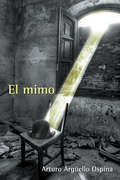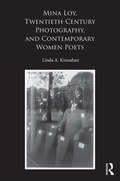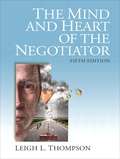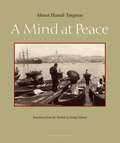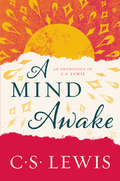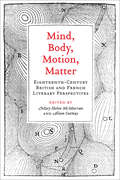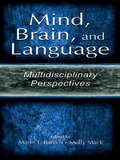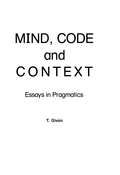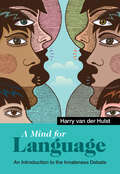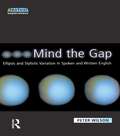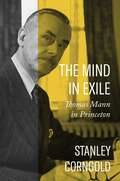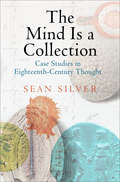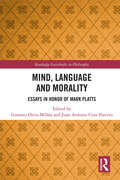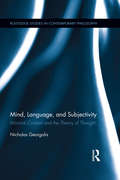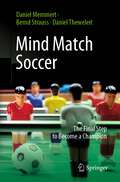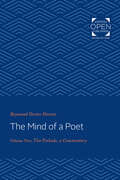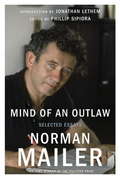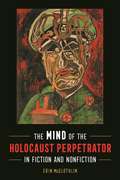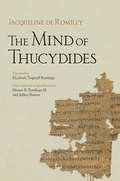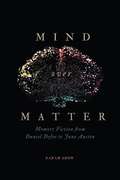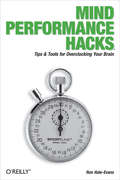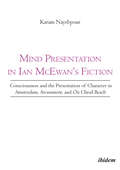- Table View
- List View
El mimo
by Arturo Argüello«La Plaza Bolívar de Bogotá es el escenario donde dos almas separadas y atormentadas, aunque unidas por un intenso amor, sobreviven el día a día de los artistas callejeros de la capital colombiana.» <P><P>Con nostalgias del cálido y mágico Caribe, con sus diferentes pasados y recuerdos felices e infelices, un mimo mulato y analfabeto y una poetisa, junto a un titiritero, un payaso, un fotógrafo, un bailarín y otros eternos buscadores de aplausos y monedas, transmiten desde su música, actuación, baile y poesía su propia visión de las miserias, vicios, pasiones y alegrías de la vida cotidiana. <P> El reencuentro y la unión sólo serán posibles si lo permiten estas intensas y a veces incontrolables pasiones.
Min and Fin (Word Family Readers)
by Liza CharlesworthMin and Fin are twins! Meet them both in this terrific tale that teaches lots and lots of -in words.
Mina Loy, Twentieth-Century Photography, and Contemporary Women Poets
by Linda A. KinnahanIn Mina Loy, Twentieth-Century Photography, and Contemporary Women Poets, Linda A. Kinnahan explores the making of Mina Loy’s late modernist poetics in relation to photography’s ascendance, by the mid-twentieth century, as a distinctively modern force shaping representation and perception. As photography develops over the course of the century as an art form, social tool, and cultural force, Loy’s relationship to a range of photographic cultures emerging in the first half of the twentieth century suggests how we might understand not only the intriguing work of this poet, but also the shaping impact of photography and new technologies of vision upon modernist poetics. Framing Loy’s encounters with photography through intersections of portraiture, Surrealism, fashion, documentary, and photojournalism, Kinnahan draws correspondences between Loy’s late poetry and visual discourses of the body, urban poverty, and war, discerning how a visual rhetoric of gender often underlies these mappings and connections. In her final chapter, Kinnahan examines two contemporary poets who directly engage the camera’s modern impact –Kathleen Fraser and Caroline Bergvall – to explore the questions posed in their work about the particular relation of the camera, the photographic image, and the construction of gender in the late twentieth century.
The Mind and Heart of the Negotiator (5th Edition)
by Leigh ThompsonDelve into the mind and heart of the negotiator in order to enhance negotiation skills. The Mind and Heart of the Negotiator is dedicated to negotiators who want to improve their ability to negotiate--whether in multimillion-dollar business deals or personal interactions. This text provides an integrated view of what to do and what to avoid at the bargaining table, facilitated by an integration of theory, scientific research, and practical examples. This edition contains new examples and chapter-opening sections, as well as more than a hundred new scientific articles on negotiations.
A Mind at Peace
by Erdag Goknar Ahmet Hamdi TaniparSurviving the childhood trauma of his parents' untimely deaths in the early skirmishes of World War I, Mümtaz is raised and mentored in Istanbul by his cousin Ihsan and his cosmopolitan family of intellectuals. Having lived through the tumultuous cultural revolutions following the fall of the Ottoman Empire and the rise of the early Turkish Republic, each is challenged by the difficulties brought about by such rapid social change.The promise of modernization and progress has given way to crippling anxiety rather than hope for the future. Fragmentation and destabilization seem the only certainties within the new World where they now find themselves. Mümtaz takes refuge in the fading past, immersing himself in literature and music, but when he falls in love with Nuran, a complex woman with demanding relatives, he is forced to confront the challenges of the World at large. Can their love save them from the turbulent times and protect them from disaster, or will inner obsessions, along with powerful social forces seemingly set against them, tear the couple apart?A Mind at Peace, originally published in 1949 is a magnum opus, a Turkish Ulysses and a lyrical homage to Istanbul. With an innate awareness of how dueling cultural mentalities can lead to the distress of divided selves, Tanpinar gauges this moment in history by masterfully portraying its register on the layered psyches of his Istanbulite characters.
A Mind Awake: An Anthology of C. S. Lewis
by C. S. LewisA repackaged edition of the revered author’s anthology featuring hundreds of selections from his writings, organized by the main themes of Christian faith.C. S. Lewis—the great British writer, scholar, lay theologian, broadcaster, Christian apologist, and bestselling author of Mere Christianity, The Screwtape Letters, The Great Divorce, The Chronicles of Narnia, and many other beloved classics—wrote widely on all the main themes of Christian faith: God, Jesus, the Trinity, Scripture, sin, evil, nature, sex, the Christian life, prayer, faith, compassion, guilt, and forgiveness. A Mind Awake includes hundreds of short excerpts, curated from the full range of his works and organized them by theme. Useful as both a reference work and as a devotional resource, A Mind Awake contains hidden gems of wisdom that are provocative, whimsical, and insightful, and is an ideal introduction to this towering figure who has profoundly influenced modern Christianity.
Mind, Body, Motion, Matter: Eighteenth-Century British and French Literary Perspectives
by Alison Conway Mary Helen McmurranMind, Body, Motion, Matter investigates the relationship between the eighteenth century's two predominant approaches to the natural world - mechanistic materialism and vitalism - in the works of leading British and French writers such as Daniel Defoe, William Hogarth, Laurence Sterne, the third Earl of Shaftesbury and Denis Diderot. Focusing on embodied experience and the materialization of thought in poetry, novels, art, and religion, the literary scholars in this collection offer new and intriguing readings of these canonical authors. Informed by contemporary currents such as new materialism, cognitive studies, media theory, and post-secularism, their essays demonstrate the volatility of the core ideas opened up by materialism and the possibilities of an aesthetic vitalism of form.
Mind, Brain, and Language: Multidisciplinary Perspectives
by Marie T. Banich Molly MackMuch of the groundbreaking work in many fields is now occurring at the intersection of traditional academic disciplines. This development is well demonstrated in this important and unique volume, which offers a multidisciplinary view of current findings and cutting-edge issues involving the relationship between mind, brain, and language. Marie T. Banich and Molly Mack have edited a collection of 11 invited chapters from top researchers (and have contributed two of their own chapters) to create a volume organized around five major topics--language emergence, influence, and development; models of language and language processing; the neurological bases of language; language disruption and loss; and dual-language systems. Topics range from the evolution of language and child-language acquisition to brain imaging and the "bilingual brain." To maintain continuity throughout, care has been taken to ensure that the chapters have been written in a style accessible to scholars across many disciplines, from anthropology and psycholinguistics to cognitive science and neurobiology. Because of its depth and breadth, this book is appropriate both as a textbook in a variety of undergraduate and graduate-level courses and as a valuable resource for researchers and scholars interested in further understanding the background of and current developments in our understanding of the mind/brain/language relationship.
Mind, Brain and Narrative
by Anthony J. Sanford Catherine EmmottNarratives enable readers to vividly experience fictional and non-fictional contexts. Writers use a variety of language features to control these experiences: they direct readers in how to construct contexts, how to draw inferences and how to identify the key parts of a story. Writers can skilfully convey physical sensations, prompt emotional states, effect moral responses and even alter the readers' attitudes. Mind, Brain and Narrative examines the psychological and neuroscientific evidence for the mechanisms which underlie narrative comprehension. The authors explore the scientific developments which demonstrate the importance of attention, counterfactuals, depth of processing, perspective and embodiment in these processes. In so doing, this timely, interdisciplinary work provides an integrated account of the research which links psychological mechanisms of language comprehension to humanities work on narrative and style.
Mind, Code and Context: Essays in Pragmatics (Neuropsychology and Neurolinguistics Series)
by T. GivonScholars concerned with the phenomenon of mind have searched through history for a principled yet non-reductionist approach to the study of knowledge, communication, and behavior. Pragmatics has been a recurrent theme in Western epistemology, tracing itself back from pre-Socratic dialectics and Aristotle's bio- functionalism, all the way to Wittgenstein's content-dependent semantics. This book's treatment of pragmatics as an analytic method focuses on the central role of context in determining the perception, organization, and communication of experience. As a bioadaptive strategy, pragmatics straddles the middle ground between absolute categories and the non-discrete gradation of experience, reflecting closely the organism's own evolutionary compromises. In parallel, pragmatic reasoning can be shown to play a pivotal role in the process of empirical science, through the selection of relevant facts, the abduction of likely hypotheses, and the construction of non-trivial explanations. In this volume, Professor Givon offers pragmatics as both an analytic method and a strategic intellectual framework. He points out its relevance to our understanding of traditional problems in philosophy, anthropology, linguistics, cognitive psychology, neuro-biology, and evolution. Finally, the application of pragmatics to the study of the mind and behavior constitutes an implicit challenge to the current tenets of artificial intelligence.
Mind The Gap: Ellipsis and Stylistic Variation in Spoken and Written English (Textual Explorations)
by Peter WilsonWe rarely speak or even write in the complete sentences that are often held to be the ideal form of linguistic communication. Language is, in fact, full of gaps, because speakers and writers operate in contexts which allow bits of language to be understood rather than expressed. This book systematically analyses this inherent gappiness of language, known as ellipsis, and provides an account of the different contexts, both linguistic and situational, which affect its use. Peter Wilson draws on a wide variety of examples of spoken and written English, and both literary and non-literary to present a comprehensive classification of elliptical language that ranges from the conversational fragment and the advertisement to the dialogue of Shakespeare and imagist poetry. Mind the Gap shows how ellipsis is a feature of major structural and stylistic importance to our understanding of spoken and written language, and will be of interest to undergraduate students of linguistics, literature, communication and the interrelations between them..
The Mind in Exile: Thomas Mann in Princeton
by Stanley CorngoldA unique look at Thomas Mann’s intellectual and political transformation during the crucial years of his exile in the United StatesIn September 1938, Thomas Mann, the Nobel Prize–winning author of Death in Venice and The Magic Mountain, fled Nazi Germany for the United States. Heralded as “the greatest living man of letters,” Mann settled in Princeton, New Jersey, where, for nearly three years, he was stunningly productive as a novelist, university lecturer, and public intellectual. In The Mind in Exile, Stanley Corngold portrays in vivid detail this crucial station in Mann’s journey from arch-European conservative to liberal conservative to ardent social democrat.On the knife-edge of an exile that would last fully fourteen years, Mann declared, “Where I am, there is Germany. I carry my German culture in me.” At Princeton, Mann nourished an authentic German culture that he furiously observed was “going to the dogs” under Hitler. Here, he wrote great chunks of his brilliant novel Lotte in Weimar (The Beloved Returns); the witty novella The Transposed Heads; and the first chapters of Joseph the Provider, which contain intimations of his beloved President Roosevelt’s economic policies. Each of Mann’s university lectures—on Goethe, Freud, Wagner—attracted nearly 1,000 auditors, among them the baseball catcher, linguist, and O.S.S. spy Moe Berg. Meanwhile, Mann had the determination to travel throughout the United States, where he delivered countless speeches in defense of democratic values.In Princeton, Mann exercised his “stupendous capacity for work” in a circle of friends, all highly accomplished exiles, including Hermann Broch, Albert Einstein, and Erich Kahler. The Mind in Exile portrays this luminous constellation of intellectuals at an extraordinary time and place.
The Mind Is a Collection: Case Studies in Eighteenth-Century Thought (Material Texts)
by Sean SilverJohn Locke described the mind as a cabinet; Robert Hooke called it a repository; Joseph Addison imagined a drawer of medals. Each of these philosophers was an avid collector and curator of books, coins, and cultural artifacts. It is therefore no coincidence that when they wrote about the mental work of reason and imagination, they modeled their powers of intellect in terms of collecting, cataloging, and classification.The Mind Is a Collection approaches seventeenth- and eighteenth-century metaphors of the mind from a material point of view. Each of the book's six chapters is organized as a series of linked exhibits that speak to a single aspect of Enlightenment philosophies of mind. From his first chapter, on metaphor, to the last one, on dispossession, Sean Silver looks at ways that abstract theories referred to cognitive ecologies—systems crafted to enable certain kinds of thinking, such as libraries, workshops, notebooks, collections, and gardens. In doing so, he demonstrates the crossings-over of material into ideal, ideal into material, and the ways in which an idea might repeatedly turn up in an object, or a range of objects might repeatedly stand for an idea. A brief conclusion examines the afterlife of the metaphor of mind as collection, as it turns up in present-day cognitive studies. Modern cognitive theory has been applied to the microcomputer, and while the object is new, the habit is as old as the Enlightenment.By examining lived environments and embodied habits from 1660 to 1800, Silver demonstrates that the philosophical dualism that separated mind from body and idea from thing was inextricably established through active engagement with crafted ecologies.
Mind, Language and Morality: Essays in Honor of Mark Platts (Routledge Festschrifts in Philosophy)
by Gustavo Ortiz-Millán Juan Antonio Cruz ParceroMark Platts is responsible for the first systematic presentation of truth-conditional semantics and for turning a generation of philosophers on to the Davidsonian program. He is also a pioneer in discussions of moral realism, and has made important contributions to bioethics, the philosophy of human rights and moral responsibility. This book is a tribute to Platts’s pioneering work in these areas, featuring contributions from number of leading scholars of his work from the US, UK and Mexico. It features replies to the individual essays from Platts, as well as a concluding chapter reflecting on his philosophical career from Oxford to Mexico City. Mind, Language and Morality will be of interest to philosophers across a wide range of areas, including ethics, moral psychology, philosophy of law, and philosophy of language.
Mind, Language and Subjectivity: Minimal Content and the Theory of Thought (Routledge Studies in Contemporary Philosophy)
by Nicholas GeorgalisIn this monograph Nicholas Georgalis further develops his important work on minimal content, recasting and providing novel solutions to several of the fundamental problems faced by philosophers of language. His theory defends and explicates the importance of ‘thought-tokens’ and minimal content and their many-to-one relation to linguistic meaning, challenging both ‘externalist’ accounts of thought and the solutions to philosophical problems of language they inspire. The concepts of idiolect, use, and statement made are critically discussed, and a classification of kinds of utterances is developed to facilitate the latter. This is an important text for those interested in current theories and debates on philosophy of mind, philosophy of language, and their points of intersection.
Mind Match Soccer: The Final Step to Become a Champion
by Daniel Memmert Bernd Strauss Daniel TheweleitClose soccer matches and tight title fights are rarely decided by players' technical skills or their coaches' tactical measures. The most significant impetus comes from an area that is often mentioned but difficult to grasp: mental strength, personality, and team cohesion after special victories. Using current scientific knowledge and illustrated by many examples, this book describes the mental and cognitive processes that determine victory and defeat in soccer. Several interviews with well-known soccer coaches, managers and former players complement these findings from psychology and sport science.It deals with phenomena such as the home field advantage, creativity on the field, extreme emotional situations, the limits of visual perception, group dynamics and modern leadership. Well-known myths (e.g. Don't let the player who has been fouled shoot the penalty) will be discussed and debunked. Every soccer enthusiast should read this book in order to understand which phenomena can genuinely be game-changing and which ones cannot.
The Mind of a Poet: The Prelude, Commentary
by Raymond Dexter HavensThis book seeks to study the mind of a poet, specifically by picking William Wordsworth as a case study. The reason for signaling out Wordsworth as the person in whom to study the mind of a poet is that The Prelude reveals with unusual fullness a mind that is fundamentally poetic. Even its peculiarities, its numerous limitations, and its unusual emphases are in the main those of a poet. Besides, poetry—not, as with many other writers, religious or social problems, humanitarianism, science, politics, economics, metaphysics, or literary criticism—was the chief concern of his creative years. Further, the sheer amount of verse, criticism, letters, and journals Wordsworth produced makes him an excellent choice for a study of this kind.
The Mind of a Poet: A Study of Wordsworth's Thought with Particular Reference to "The Prelude"
by Raymond Dexter HavensOriginally published in 1941. This book stresses the transcendental, rather than purely aesthetic, qualities of William Wordsworth's work. It argues that the unusual aspects of Wordsworth's mind are not isolated and did not seem to him fanciful or merely personal; they were, for him, so many paths, difficult to find and harder to follow, yet leading to the great central truth that is the goal of all humankind's loftier strivings.
Mind of an Outlaw
by Jonathan Lethem Phillip Sipiora Norman MailerNorman Mailer was one of the towering figures of twentieth-century American letters and an acknowledged master of the essay. Mind of an Outlaw, the first posthumous publication from this outsize literary icon, collects Mailer's most important and representative work in the form that many rank as his most electrifying. As America's foremost public intellectual, Norman Mailer was a ubiquitous presence in our national life--on the airwaves and in print--for more than sixty years. With his supple mind and pugnacious persona, he engaged society more than any other writer of his generation. The trademark Mailer swagger is much in evidence in these pages as he holds forth on culture, ideology, politics, sex, gender, and celebrity, among other topics. Here is Mailer on boxing, Mailer on Hemingway, Mailer on Marilyn Monroe, and, of course, Mailer on Mailer--the one subject that served as the beating heart of all of his nonfiction. From his early essay "A Credo for the Living," published in 1948, when the author was twenty-five, to his final writings in the year before his death, Mailer wrestled with the big themes of his times. He was one of the most astute cultural commentators of the postwar era, a swashbuckling intellectual provocateur who never pulled a punch and was rarely anything less than interesting. Mind of an Outlaw spans the full arc of Mailer's evolution as a writer, including such essential pieces as his acclaimed 1957 meditation on hipsters, "The White Negro"; multiple selections from his seminal collection Advertisements for Myself; and a never-before-published essay on Sigmund Freud. Incendiary, erudite, and unrepentantly outrageous, Norman Mailer was a dominating force on the battlefield of ideas. Featuring an incisive Introduction by Jonathan Lethem, Mind of an Outlaw forms a fascinating portrait of Mailer's intellectual development across the span of his career as well as the preoccupations of a nation in the last half of the American century.
The Mind of the Holocaust Perpetrator in Fiction and Nonfiction
by Erin McGlothlinThe Mind of the Holocaust Perpetrator in Fiction and Nonfiction examines texts that portray the inner experience of Holocaust perpetrators and thus transform them from archetypes of evil into complex psychological and moral subjects. Employing relevant methodological tools of narrative theory, Erin McGlothlin analyzes these unsettling depictions, which manifest a certain tension regarding the ethics of representation and identification. Such works, she asserts, endeavor to make transparent the mindset of their violent subjects, yet at the same time they also invariably contrive to obfuscate in part its disquieting character. The Mind of the Holocaust Perpetrator in Fiction and Nonfiction contains two parts. The first focuses on portraits of real-life perpetrators in nonfictional interviews and analyses from the 1960s and 1970s. These works provide a nuanced perspective on the mentality of the people who implemented the Holocaust via the interventional role of the interviewer or interpreter in the perpetrators’ performances of self-disclosure. In part two, McGlothlin investigates more recent fictional texts that imagine the perspective of their invented perpetrator-narrators. Such works draw readers directly into the perpetrator’s experience and at the same time impede their access to the perpetrator’s consciousness by retarding their affective connection. Demonstrating that recent fiction featuring perpetrators as narrators employs strategies derived from earlier nonfictional portrayals, McGlothlin establishes not only a historical connection between these two groups of texts, whereby nonfictional engagement with real-life perpetrators gradually gives way to fictional exploration, but also a structural and aesthetic one. The book bespeaks new modes of engagement with ethically fraught questions raised by our increasing willingness to consider the events of the Holocaust from the perspective of the perpetrator. Students, scholars, and readers of Holocaust studies and literary criticism will appreciate this closer look at a historically taboo topic.
The Mind of Thucydides (Cornell Studies in Classical Philology #62)
by Jacqueline de RomillyThe publication of Jacqueline de Romilly’s Histoire et raison chez Thucydide in 1956 virtually transformed scholarship on Thucydides. Rather than mining The Peloponnesian War to speculate on its layers of composition or second-guess its accuracy, it treated it as a work of art deserving rhetorical and aesthetic analysis. Ahead of its time in its sophisticated focus upon the verbal texture of narrative, it proved that a literary approach offered the most productive and nuanced way to study Thucydides. Still in print in the original French, the book has influenced numerous Classicists and historians, and is now available in English for the first time in a careful translation by Elizabeth Trapnell Rawlings. The Cornell edition includes an introduction by Hunter R. Rawlings III and Jeffrey Rusten tracing the context of this book’s original publication and its continuing influence on the study of Thucydides.Romilly shows that Thucydides constructs his account of the Peloponnesian War as a profoundly intellectual experience for readers who want to discern the patterns underlying historical events. Employing a commanding logic that exercises total control over the data of history, Thucydides uses rigorous principles of selection, suggestive juxtapositions, and artfully opposed speeches to reveal systematic relationships between plans and outcomes, impose meaning on the smallest events, and insist on the constant battle between intellect and chance. Thucydides’ mind found in unity and coherence its ideal of historical truth.
Mind over Matter: Memory Fiction from Daniel Defoe to Jane Austen
by Sarah EronHow do we understand memory in the early novel? Departing from traditional empiricist conceptualizations of remembering, Mind over Matter uncovers a social model of memory in Enlightenment fiction that is fluid and evolving—one that has the capacity to alter personal histories. Memories are not merely imprints of first-hand experience stored in the mind, but composite stories transacted through dialogue and reading.Through new readings of works by Daniel Defoe, Frances Burney, Laurence Sterne, Jane Austen, and others, Sarah Eron tracks the fictional qualities of memory as a force that, much like the Romantic imagination, transposes time and alters forms. From Crusoe’s island and Toby’s bowling green to Evelina’s garden and Fanny’s east room, memory can alter, reconstitute, and even overcome the conditions of the physical environment. Memory shapes the process and outcome of the novel’s imaginative world-making, drafting new realities to better endure trauma and crises. Bringing together philosophy of mind, formalism, and narrative theory, Eron highlights how eighteenth-century novelists explored remembering as a creative and curative force for literary characters and readers alike. If memory is where we fictionalize reality, fiction—and especially the novel—is where the truths of memory can be found.
Mind Performance Hacks: Tips & Tools for Overclocking Your Brain
by Ron Hale-EvansYou're smart. This book can make you smarter.Mind Performance Hacks provides real-life tips and tools for overclocking your brain and becoming a better thinker. In the increasingly frenetic pace of today's information economy, managing your life requires hacking your brain. With this book, you'll cut through the clutter and tune up your brain intentionally, safely, and productively.Grounded in current research and theory, but offering practical solutions you can apply immediately, Mind Performance Hacks is filled with life hacks that teach you to:Use mnemonic tricks to remember numbers, names, dates, and other flotsam you need to recallPut down your calculator and perform complex math in your head, with your fingers, or on the back of a napkinSpark your creativity with innovative brainstorming methodsUse effective systems to capture new ideas before they get awayCommunicate in creative new ways-even using artificial languagesMake better decisions by foreseeing problems and finding surprising solutionsImprove your mental fitness with cool tricks and gamesWhile the hugely successful Mind Hacks showed you how your brain works, Mind Performance Hacks shows you how to make it work better.
Mind Presentation in Ian McEwan's Fiction: Consciousness and the Presentation of Character in Amsterdam, Atonement, and On Chesil Beach
by Karam NayebpourThis book explores the central fictional minds in three of Ian McEwan's most popular narratives. Mind presentation constitutes the main part of characterization in the second phase of McEwan's writing, where his plot structure depends to a large degree on the presentation of the characters' mental workings. In Amsterdam (1998), Atonement (2003), and On Chesil Beach (2007), the construction process of the fictional minds, the degree their functioning is impacted by their experiences, and the way their mental aspect controls their behavior and relationships are critical to the stories. Relying on insights and methods from cognitive narratology, this study follows two purposes: It firstly analyzes the function of fictional minds and their operational modes in these narratives. Secondly, it explores the impact of the characters' experiences on both their mental functioning and their behavior, especially with view of their relationships. Nayebpour reveals that the plot structure of these narratives highly depends on the lack of a sound balance between the two aspects of the represented minds (intermental/joint thought and intramental/individual thought) as well as on the dominance of the intramental one. The tragic atmosphere in these narratives, Nayebpour argues, is the result of this imbalance.
